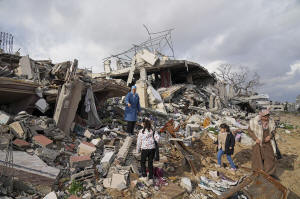Palestinians struggle to restart their lives in the ruins of Gaza
 Send a link to a friend
Send a link to a friend
 [February 25, 2025]
By FATMA KHALED and ABDEL KAREEM HANA [February 25, 2025]
By FATMA KHALED and ABDEL KAREEM HANA
BEIT LAHIYA, Gaza Strip (AP) — When night falls over northern Gaza, much
of the cityscape of collapsed buildings and piled wreckage turns pitch
black. Living inside the ruins of their home, Rawia Tambora’s young sons
get afraid of the dark, so she turns on a flashlight and her phone’s
light to comfort them, for as long as the batteries last.
Displaced for most of the 16-month-long war, Tambora is back in her
house. But it is still a frustrating shell of a life, she says: There is
no running water, electricity, heat or services, and no tools to clear
the rubble around them.
Nearly 600,000 Palestinians flooded back into northern Gaza under the
now month-old ceasefire in Gaza, according to the United Nations. After
initial relief and joy at being back at their homes — even if damaged or
destroyed — they now face the reality of living in the wreckage for the
foreseeable future.
“Some people wish the war had never ended, feeling it would have been
better to be killed,” Tambora said. “I don’t know what we’ll do
long-term. My brain stopped planning for the future.”
The six-week ceasefire is due to end Saturday, and it’s uncertain what
will happen next. There are efforts to extend the calm as the next phase
is negotiated. If fighting erupts again, those who returned to the north
could find themselves once again in the middle of it.

A massive rebuilding job has no way to start
A report last week by the World Bank, U.N. and European Union estimated
it will cost some $53 billion to rebuild Gaza after entire neighborhoods
were decimated by Israel’s bombardment and offensives against Hamas
militants. At the moment, there is almost no capacity or funding to
start significant rebuilding.
A priority is making Gaza immediately livable. Earlier in February,
Hamas threatened to hold up hostage releases unless more tents and
temporary shelters were allowed into Gaza. It then reversed and
accelerated hostage releases after Israel agreed to let in mobile homes
and construction equipment.
Humanitarian agencies have stepped up services, setting up free kitchens
and water delivery stations, and distributing tents and tarps to
hundreds of thousands across Gaza, according to the U.N.
President Donald Trump turned up the pressure by calling for the entire
population of Gaza to be removed permanently so the U.S. can take over
the territory and redevelop it for others. Rejecting the proposal,
Palestinians say they want help to rebuild for themselves.
Gaza City’s municipality started fixing some water lines and clearing
rubble from streets, said a spokesperson, Asem Alnabih. But it lacks
heavy equipment. Only a few of its 40 bulldozers and five dump trucks
still work, he said. Gaza is filled with over 50 million tons of rubble
that would take 100 trucks working at full capacity over 15 years to
clear away, the U.N. estimates.
Families try to get by day by day
Tambora’s house in the northern town of Beit Lahiya was destroyed by an
airstrike early in the war, so she and her family lived in the nearby
Indonesian Hospital, where she worked as a nurse.
After the ceasefire, they moved back into the only room in her house
that was semi-intact. The ceiling is partially collapsed, the walls are
cracked; the surviving fridge and sink are useless with no water or
electricity. They stack their sheets and blankets in a corner.
[to top of second column]
|

Members of the Dwaima family stand on the rubble of their home,
which was leveled by an Israeli airstrike during the Israel-Hamas
war, in the Tal al Hawa neighborhood in Gaza City, Monday, Feb. 24,
2025. (AP Photo/Abdel Kareem Hana)

Tambora said her 12-year-old son lugs heavy containers of water twice a
day from distribution stations. They also have to find firewood for
cooking. The influx of aid means there is food in the markets and prices
went down, but it remains expensive, she said.
With the Indonesian Hospital too damaged to function, Tambora walks an
hour each day to work at the Kamal Adwan Hospital. She charges her and
her husband’s phones using the hospital generator.
Many of Tambora’s relatives returned to find nothing left of their
homes, so they live in tents on or next to the rubble that gets blown
away by winter winds or flooded during rains, she said.
Asmaa Dwaima and her family returned to Gaza City but had to rent an
apartment because their home in the Tel al-Hawa neighborhood was
destroyed. It was only weeks after returning that she went to visit
their four-story house, now a pile of flattened and burned wreckage.
“I couldn’t come here because I was afraid. I had an image of my house
in my mind — its beauty, and warmth. ... I was afraid to face this
truth,” the 25-year-old dentist said. “They don’t just destroy stone,
they are destroying us and our identity.”
Her family had to rebuild the house once before, when it was leveled by
airstrikes during a round of fighting between Israel and Hamas in 2014,
she said. For the time being, they have no means to rebuild now.
“We need to remove the rubble because we want to pull out clothes and
some of our belongings,” she said. “We need heavy equipment … There are
no bricks or other construction tools and, if available, it’s extremely
expensive.”
Desperation is growing
Tess Ingram, a spokesperson with UNICEF who visited northern Gaza since
the ceasefire, said the families she met are “grieving the lives that
they used to live as they begin to rebuild.”
Their desperation, she said, "is becoming more intense.”
Huda Skaik, a 20-year-old student, is sharing a room with her three
siblings and parents at her grandparents’ house in Gaza City. It’s an
improvement from life in the tent camps of central Gaza where they were
displaced for much of the war, she said. There, they had to live among
strangers, and their tent was washed away by rain. At least here they
have walls and are with family, she said.

Before the war interrupted, Skaik had just started studying English
literature at Gaza’s Islamic University. She is now enrolled in online
classes the university is organizing. But the internet is feeble, and
her electricity relies on solar panels that don’t always work.
“The worst part is that we’re just now grasping that we lost it all,”
she said. “The destruction is massive, but I’m trying to remain
positive.”
___
Khaled reported from Cairo.
All contents © copyright 2025 Associated Press. All rights reserved |